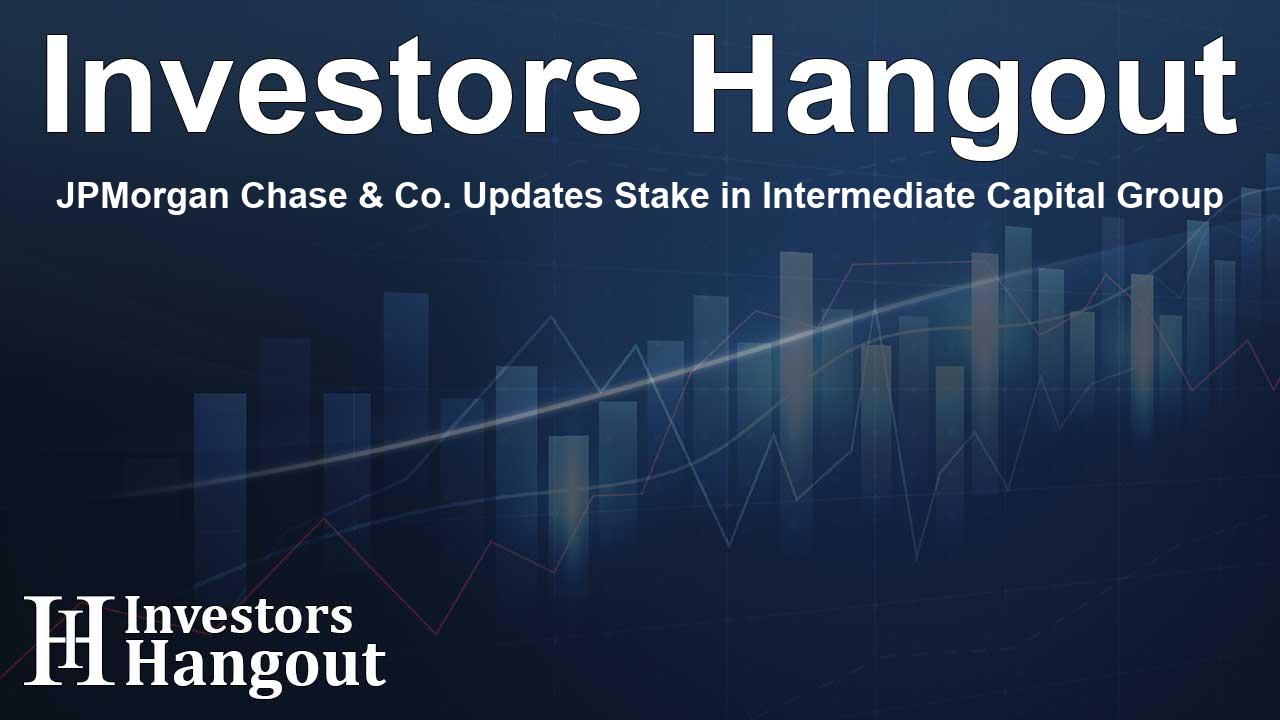JPMorgan Chase & Co. Updates Stake in Intermediate Capital Group

Understanding the Recent Stake Notification by JPMorgan Chase & Co.
In the world of finance, notifications regarding major holdings can often symbolize significant changes in a company's landscape. Recently, JPMorgan Chase & Co. made headlines with their notification concerning Intermediate Capital Group Plc (LSE: ICG), shedding light on their shareholding dynamics.
JPMorgan Chase & Co.: An Overview
JPMorgan Chase & Co. stands as a pivotal entity in global finance, offering a wide array of financial services nationwide and internationally. This commitment to diverse financial solutions has solidified JPMorgan's reputation as a leader in the financial sector. Their advisory, capital markets, and wealth management services showcase their comprehensive approach to finance.
The Details of the Notification
According to the notification submitted under the TR-1 standard form, this recent acquisition or disposal of voting rights showcases JPMorgan's strategic adjustments. As defined by the notification, action was tied to their position in Intermediate Capital Group Plc.
What This Means for Intermediate Capital Group
For Intermediate Capital Group, which plays a substantial role in private equity and alternative investment markets, changes in stakeholder positions can influence investment strategies and future directions. The details regarding the percentage of voting rights attached to shares and financial instruments further illustrate the shifting landscape.
The Impact of the Threshold Crossing
As highlighted in the notification, JPMorgan Chase & Co. has crossed a threshold, indicating that their voting rights have either increased or decreased, now reflecting a position that is below the minimum threshold. Such adjustments in shareholding stakes can evoke strategic evaluations and possible realignments within the company's operational strategies.
Shareholder Composition and Voting Rights
The notification also included insights on the shareholder dynamics at play. Notably, JPMorgan Securities plc, acting on behalf of JPMorgan Chase & Co., reflects the intricate web of controlled undertakings that manage a chain of ownership for voting rights. Keeping track of how these rights are distributed and potentially manipulated is crucial for both the issuer and investors alike.
Connecting the Dots: Full Chain of Controlled Undertakings
In their notification, JPMorgan laid out a comprehensive chain of controlled entities, including JPMorgan Chase Bank and J.P. Morgan International Finance Limited. This structured hierarchy not only consolidates their holdings but also asserts their footprint within the financial markets. The clarity provided through such disclosures reinforces commitment to transparency and compliance, while depicting their extensive reach.
Future Implications for Investors
For investors tracking positions like that of Intermediate Capital Group, understanding stakeholder movements can provide invaluable insights. The notification serves as a reminder of how interconnected these entities are and the weight that such disclosures carry in influencing prospective investment decisions.
Periodical Disclosure and Financial Regulations
Financial regulations mandate these notifications to ensure public awareness of significant holdings. This not only upholds the integrity of the market but also facilitates a clear dialogue regarding company governance. Investors often devise their strategies based on these disclosures, using them as indicators for potential stock performance and corporate governance.
Conclusion: The Broader Financial Landscape
The recent notification from JPMorgan Chase & Co. regarding Intermediate Capital Group Plc represents more than just numbers; it's a story of strategic positioning and market dynamics that shape the future of investment decisions. As stakeholders remain vigilant about such updates, the interconnectedness of global finance continues to evolve, ensuring that every notification has the potential to influence financial narratives.
Frequently Asked Questions
What does the TR-1 notification entail?
The TR-1 form is a standard notification method for significant changes in shareholdings, particularly regarding voting rights in publicly traded companies.
Who is affected by changes in voting rights?
Both the issuers, such as Intermediate Capital Group, and existing shareholders are affected, as shifts in voting rights can influence company decisions and strategies.
What is the significance of the minimum threshold?
The minimum threshold in shareholding represents the required level of ownership necessary for a shareholder's voting rights to influence company decisions significantly.
How do financial instruments impact voting rights?
Financial instruments may grant or alter voting rights in various ways, reflecting a shareholder's economic influence over the company's management and strategic direction.
Why is transparency in financial disclosures important?
Transparency in financial disclosures fosters trust among investors and maintains market integrity by ensuring that significant movements in shareholdings are publicly known.
About Investors Hangout
Investors Hangout is a leading online stock forum for financial discussion and learning, offering a wide range of free tools and resources. It draws in traders of all levels, who exchange market knowledge, investigate trading tactics, and keep an eye on industry developments in real time. Featuring financial articles, stock message boards, quotes, charts, company profiles, and live news updates. Through cooperative learning and a wealth of informational resources, it helps users from novices creating their first portfolios to experts honing their techniques. Join Investors Hangout today: https://investorshangout.com/
Disclaimer: The content of this article is solely for general informational purposes only; it does not represent legal, financial, or investment advice. Investors Hangout does not offer financial advice; the author is not a licensed financial advisor. Consult a qualified advisor before making any financial or investment decisions based on this article. The author's interpretation of publicly available data shapes the opinions presented here; as a result, they should not be taken as advice to purchase, sell, or hold any securities mentioned or any other investments. The author does not guarantee the accuracy, completeness, or timeliness of any material, providing it "as is." Information and market conditions may change; past performance is not indicative of future outcomes. If any of the material offered here is inaccurate, please contact us for corrections.